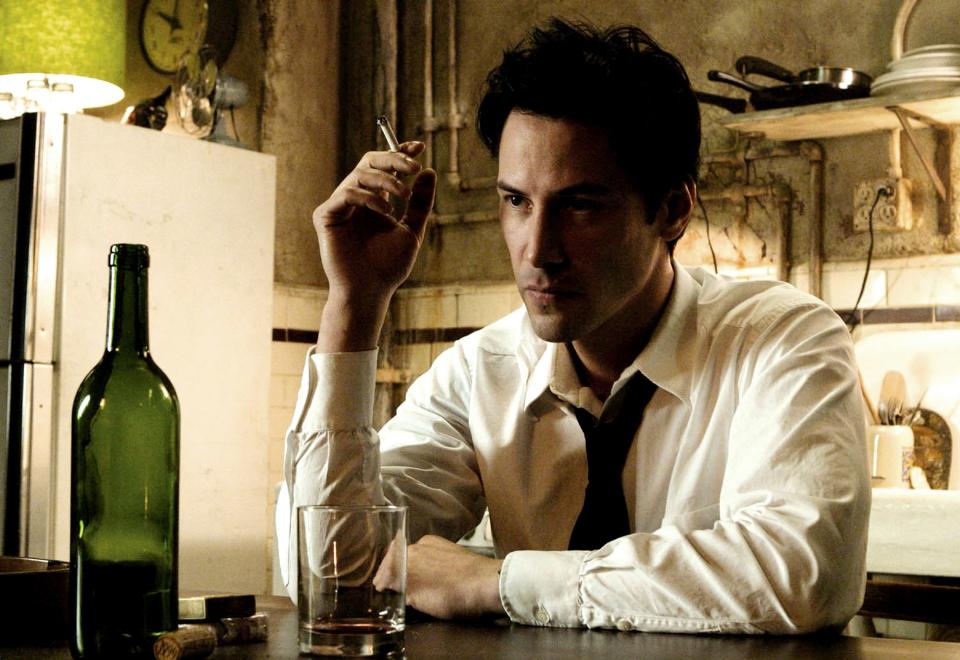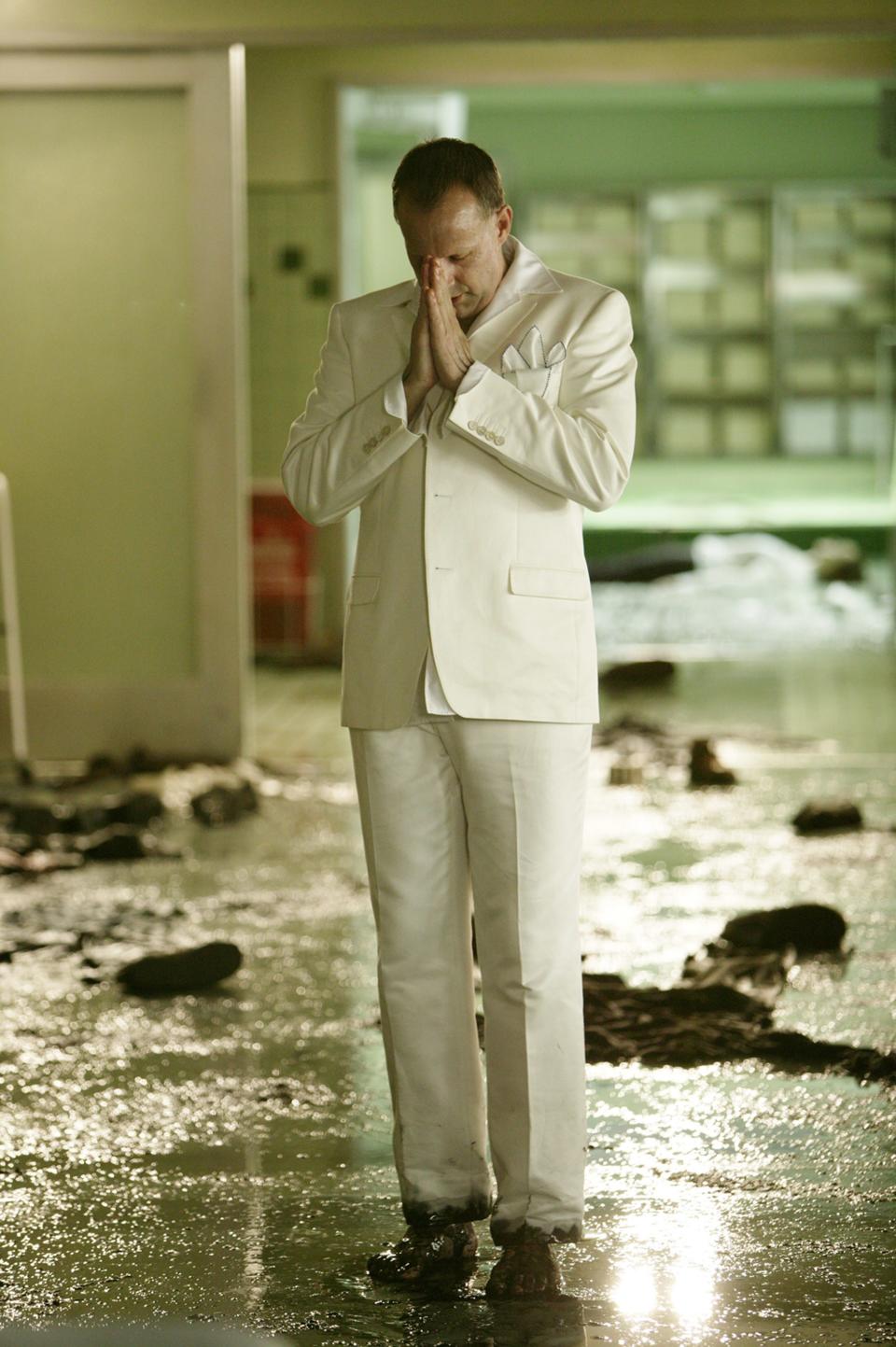Keanu Reeves's Constantine Left a Weird and Wonderful Legacy
Last year, I bruised my coccyx from spending a weekend at a Keanu Reeves-themed film festival in a tiny Glasgow theater. Included in that day's marathon was Constantine, the DC comic book adaptation starring Reeves as the chain-smoking detective John Constantine, who banishes demons in order to buy his way into heaven. At the time of its release, Constantine was critically maligned, but in the theater that day, there was a buzz radiating from the crowd of Keanu devotees as we watched our suited-up protagonist perform exorcisms with delightfully mellow charisma. As John momentarily rises to those pearly gates, he flashes the middle finger, which elicited whoops and hollers from the room. It was clear, then and there, that we would follow Reeves to heaven and hell.
In the 15 years since its release, Constantine has swelled to beloved cult classic status, but it certainly hasn’t always been so warmly embraced. In 2005, the film was released with solid if unremarkable box office returns, grossing $230 million; the critical reception on the other hand… not so much. Fans of the Hellblazer comics were unhappy with the adaptation's deviation from its source material; critics dismissed it as silly, particularly Roger Ebert, who thought that recapping the movie’s (admittedly wild) plot was enough to demonstrate its quality (or lack thereof). To be fair, on paper, Constantine reads like the movie equivalent of a My Chemical Romance concept album: Reeves’s hard-boiled private eye is like something straight out of a '40s noir. He glowers over his shoulder, face stuck with permanent scowl, and says things like “God’s a kid with an ant farm.” (Slap that on a t-shirt, Hot Topic, these ideas are free!)
Where Constantine succeeds, though, is in its deft execution of a tricky balancing act. In a film where Tilda Swinton plays an androgynous Gabriel, demonic omens appear as crabs, and cats are the gateway to the underworld, Constantine plays things completely straight. There are grandiose—and sometimes gross—set-pieces that are elevated by dramatic lighting (the heavens literally open up), CG effects that make zero attempts to achieve realism (those artificial demons do belong in hell), and a heaping dose of so-slow-time-stops slo-mo. By the time a devilish Peter Stromare, dressed all in white, descends from the sky as Lucifer, it almost feels... normal. There’s a “hear me out” attitude to the film: yes, I look stupid, Constantine says, but don’t I also look really cool?

CONSTANTINE, Keanu Reeves, 2005, (c) Warner Brothers/courtesy Everett Collection
In 2020, superhero movies arrive to us directly from the factory assembly lines: the MCU brings at least three new additions a year, not to mention impending Disney+ spinoffs, while DC is reinventing its cinematic output and shifting its style every few years to match its rival. The former has its formula locked down: without fail, each offering delivers us an aspirational hero armed with army-grade weapons (or powers, or both) and witty one-liners no matter the occasion. Their stories are bound in Hollywood’s tried and true, traditional three-act structure, one that leaves little room for the imagination. Any “shocking” deaths neatly arrive when all contractual obligations have been sorted behind closed doors. That comforting predictability is all part of a grand design intended to appeal to the masses. These movies thrive on their likable monotony—as reliable as Marvel’s go-to color palette of gray on gray—that ensures people will come back to the theaters for the next installment.
Constantine arrived well before comic book movies played it safe, arriving at a time when studios were still figuring out how the genre could make money. In the early ‘00s, comic book films were gambles that didn’t guarantee success. The Tobey Maguire era of Spider-Man proved that men in spandex were capable of delivering box office hits, but then—just as quickly as a genre began to rise—it died by finger gun. Before Watchmen got the prestige reboot treatment by HBO last fall, Zack Snyder’s film adaptation only earned a little over its $120 million budget. Going weird was, for a decent stretch in Hollywood history, a risk too big to gamble on.
Upon its release, Constantine unwittingly set the course for the end of the weird comic book movie, though it’s not like there was much of a choice in the matter. It was never really possible for the film to be a four-quadrant hit, what with it basically being biblical fan-fiction. Constantine hearkens back to when comic books were an art form on the fringes. It’s as experimental a studio film can be. By taking big swings with a hero that kids couldn’t look up to, characters who could conceivably fuck (Marvel, as we all know, sucks all sexual tension out of every movie) and a final climax that wasn’t just fighting a faceless alien army, Constantine dared to be different. Let’s not forget, John saves the world by (sigh, spoiler alert) committing suicide. Of course the comic book movies that followed could never follow its path—it’s just not satisfying. What makes Constantine’s legacy a lasting one is in how the movie wasn’t afraid to alienate its audience—in fact, it practically tried to do that.

CONSTANTINE, Peter Stormare, 2005, ©Warner Bros./courtesy Everett Collection
Constantine isn't just weird; at times, it's uncomfortable, from its frank depictions of suicide and self-harm to the truly horrific things it puts its characters through (like being devoured by insects, a violent demon breaking through a stomach, you get the gist). As John says in the film’s closing moments, “Some people like it. Some people don’t.” He’s speaking about God, but it may as well be the film’s own mantra. Constantine embraces the fact that it’s not for everyone—for a comic book movie to do that now is unthinkable. Even Joker tried to frame itself as a relevant issue movie that speaks to America—but, sorry, putting Arthur Fleck in Scorsese’s New York is not going to make comic book movies radical.
Since the birth of the Keanussance, Constantine has experienced its own overdue, thorough critical reassessment. Even Rotten Tomatoes noted that they owed the movie an apology (15 years later, the site betrayed critical consensus to argue that it’s actually good). But Constantine is not just a good film—it’s one of Keanu Reeves's best, and just last year, the actor said he has “always” wanted to step back into John Constantine’s shoes. Plus, superhero movies are gently tip-toeing back into experimentation. As Marvel and DC invite directors who aren’t just straight, white and male to helm their projects, the genre opens itself up to innovation beyond the special effects. Birds of Prey feels playful and fresh in a way few comic book movies do, while The New Mutants revisits the superhero-horror hybrid that Constantine so skillfully demonstrated is possible.
Constantine comes from a bygone era, when comic book movies were outsiders. Now they dominate the world. Constantine dared to be unappealing, to not be Joker dark, but actually dark. Constantine is niche, and that’s brave by today’s standards. When our current comic book movies need to gross $1 billion to not be a failure, superheroes are too big to go weird. We only need another Constantine to come along and save the day.
With John Wick—the third installment of which is out this May—Hollywood's most enigmatic leading man once again established himself as a bona fide action star. But who is he, really? Alex Pappademas sits down with the immortal Keanu Reeves in an attempt to separate the man from the myth.
Swallow this red pill: the indisputable ranking of the actor’s extensive filmography.
A Scottish cinema celebrated the actor’s eclectic career with games, food, and a Wyld Stallyns cover band.
Originally Appeared on GQ




